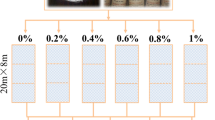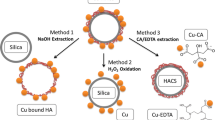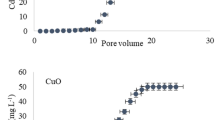Abstract
Corn cob silica (CCS), produced via a modification of the sol-gel method, can reduce heavy metal availability and stabilize contaminated soil on abandoned mining sites. Adding 5 % (w/w) CCS to mining site soil increased pH from 4.0 to 7.7, and cation exchange capacity increased from 94.5 to 100.3 cmol+/kg. Sequential extraction showed that adding CCS decreased heavy metal availability in the soil. Mobility factor (MF) values indicated that CCS reduced Pb mobility more than that of Zn or Cu in all fractions. Pb concentrations in leachate from all fractions using the toxicity characteristic leaching procedure (TCLP) were greatly decreased by adding 3 % (w/w) CCS. CCS similarly reduced Zn concentrations in TCLP leachate. CCS addition did not impact Cu concentrations in leachate, likely because concentrations were much lower than those of the other metals. As was generally less mobile than the heavy metals; however, As mobility and leachability tended to increase with CCS addition because its oxyanions arsenite and arsenate have low affinity for negatively charged surfaces on the CCS. Shoot and root growth of Spinacia oleracea L. (spinach) was much greater in CCS-treated soil than in unamended soil. Results demonstrate the utility of CCS to stabilize heavy metals in contaminated mining site soil, but this treatment may not be ideal for As-contaminated soils.







Similar content being viewed by others
References
Agemian, H., & Chau, A. Y. (1975). An atomic absorption method for the determination of 20 elements in lake sediments after acid digestion. Analytica Chimica Acta, 80, 61–66.
Brown, J. R., & Warncke, D. (1988). Recommended cation tests and measures of cation exchange capacity. In W. C. Dahnke (Ed.), Recommended chemical soil test procedures for the North Central Region, North Dakota Agricultural Experimental Station Bulletin 499 (pp. 15–16). Fargo: North Dakota Agricultural Experimental Station Bulletin.
Cao, X., Ma, L. Q., Chen, M., Singh, S. P., & Harris, W. G. (2002). Impacts of phosphate amendments on lead biogeochemistry at a contaminated site. Environmental Science and Technology, 36, 529–5304.
Cheng, S., Jang, J. H., Dempsey, B. A., & Logan, B. E. (2011). Efficient recovery of nano-sized iron oxide particles from synthetic acid-mine drainage (AMD) water using fuel cell technologies. Water Research, 45, 303–307.
Dalmacija, M., Prica, M., Dalmacija, B., Roncevic, S., & Klasnja, M. (2011). Quantifying the environmental impact of As and Cr in stabilized/solidified materials. Science of the Total Environment, 412, 366–374.
Dermatas, D., & Meng, X. (2003). Utilization of fly ash for stabilization/solidification of heavy metal contaminated soils. Engineering Geology, 70, 377–394.
Dimitrova, S. (2002). Use of granular slag columns for lead removal. Water Research, 36, 4001–4008.
Gougar, M. L. D., Scheetz, B. E., & Roy, D. M. (1996). Ettringite and C-S-H Portland cement phase for waste ion immobilization: a review. Waste Management, 16, 295–303.
Gu, H. H., Qiu, H., Tian, T., Zhan, S. S., Deng, T. H. B., Chaney, R. L., Wang, S. H., Tnag, Y. T., Morel, J. L., & Qiu, R. L. (2011). Mitigation effects of silicon rich amendments on heavy metal accumulation in rice (Oryza sativa L.) planted on multi-metal contaminated acidic soil. Chemosphere, 83, 1234–1240.
Jho, E., Lee, S., Kim, Y., & Nam, K. (2011). Facilitated desorption and stabilization of sediment-bound Pb and Cd in the presence of birnessite and apatite. Journal of Hazardous Materials, 188, 206–211.
Kalapathy, U., Proctor, A., & Shultz, J. (2000). A simple method for production of pure silica from rice hull ash. Bioresource Technology, 73, 257–262.
Kennedy, V., Sanchez, A., Oughton, D., & Rowland, A. (1997). Use of single and sequential chemical extractants to assess radionuclide and heavy metal availability from soils for root uptake. Analyst, 122(8), 89R–100R.
Kibombo, H. S., Zhao, D., Gonshorowski, A., Budhi, S., Koppang, M. D., & Koodali, R. T. (2011). Cosolvent-induced gelation and the hydrothermal enhancement of the crystallinity of titania–silica mixed oxides for the photocatalytic remediation of organic pollutants. The Journal of Physical Chemistry C, 115, 6126–6135.
Ko, M. S., Kim, J. Y., Bang, S., Lee, J. S., Ko, J. I., & Kim, K. W. (2012). Stabilization of the As-contaminated soil from the metal mining areas in Korea. Environmental Geochemistry Health, 34, 143–149.
Lee, S. H., Kim, E. Y., Park, H., Yun, J., & Kim, J. G. (2011). In situ stabilization of arsenic and metal-contaminated agricultural soil using industrial by-products. Geoderma, 161, 1–7.
Li, X., Poon, C., Sun, H., Lo, I., & Kirk, D. (2001). Heavy metal speciation and leaching behaviors in cement based solidified/stabilized waste materials. Journal of Hazardous Materials, 82, 215–230.
Liu, R., & Zhao, D. (2013). Synthesis and characterization of a new class of stabilized apatite nanoparticles and applying the particles to in situ Pb immobilization in a fire-range soil. Chemosphere, 91, 594–601.
Mallampati, S. R., Mitoma, Y., Okuda, T., Sakita, S., & Kakeda, M. (2012). Enhanced heavy metal immobilization in soil by grinding with addition of nanometallic Ca/CaO dispersion mixture. Chemosphere, 89, 717–723.
Moon, D. H., & Dermatas, D. (2006). An evaluation of lead leachability from stabilized/solidified soils under modified semi-dynamic leaching conditions. Engineering Geology, 85, 67–74.
Moulin, I., Stone, W. E., Sanz, J., Bottero, J.-Y., Mosnier, F., & Haehnel, C. (1999). Lead and zinc retention during hydration of tri-calcium silicate: a study by sorption isotherms and 29Si nuclear magnetic resonance spectroscopy. Langmuir, 15, 2829–2835.
Mullen, C. A., Boateng, A. A., Goldberg, N. M., Lima, I. M., Laird, D. A., & Hicks, K. B. (2010). Bio-oil and bio-char production from corn cobs and stover by fast pyrolysis. Biomass and Bioenergy, 34, 67–74.
Naidu, R., & Harter, R. D. (1998). Effect of different organic ligands on cadmium sorption by and extractability from soils. Soil Science Society of America Journal, 62, 644–650.
Narwal, R., Singh, B., & Salbu, B. (1999). Association of cadmium, zinc, copper, and nickel with components in naturally heavy metal‐rich soils studied by parallel and sequential extractions. Communications in Soil Science and Plant Analysis, 30, 1209–1230.
Olajire, A., Ayodele, E., Oyedirdan, G., & Oluyemi, E. (2003). Levels and speciation of heavy metals in soils of industrial southern Nigeria. Environmental Monitoring Assessment, 85, 135–155.
Pampura, T., Groenenberg, J., Lofts, S., & Priputina, I. (2007). Validation of transfer functions predicting Cd and Pb free metal ion activity in soil solution as a function of soil characteristics and reactive metal content. Water, Air, and Soil Pollution, 184, 217–234.
Park, B. D., Wi, S. G., Lee, K. H., Singh, A. P., Yoon, T. H., & Kim, Y. S. (2003). Characterization of anatomical features and silica distribution in rice husk using microscopic and micro-analytical techniques. Biomass and Bioenergy, 25, 319–327.
Rizwan, M., Meunier, J. D., Miche, H., & Keller, C. (2012). Effect of silicon on reducing cadmium toxicity in durum wheat (Triticum turgidum L. cv. Claudio W.) grown in a soil with aged contamination. Journal of Hazardous Materials, 209, 326–334.
Scheckel, K. G., & Ryan, J. A. (2002). Effects of aging and pH on dissolution kinetics and stability of chloropyromorphite. Environmental Science and Technology, 36, 2198–2204.
Sinha, S., Mallick, S., Misra, R. K., Singh, S., Basant, A., & Gupta, A. K. (2007). Uptake and translocation of metals in Spinacia oleracea L. grown on tannery sludge-amended and contaminated soils: effect on lipid peroxidation, morpho-anatomical changes and antioxidants. Chemosphere, 67, 176–187.
Song, A., Li, Z., Zhang, J., Xue, G., Fan, F., & Liang, Y. (2009). Silicon-enhanced resistance to cadmium toxicity in Brassica chinensis L. is attributed to Si-suppressed cadmium uptake and transport and Si-enhanced antioxidant defense capacity. Journal of Hazardous Materials, 172, 74–83.
Tessier, A., Campbell, P. G., & Bisson, M. (1979). Sequential extraction procedure for the speciation of particulate trace metals. Analytical Chemistry, 51(7), 844–851.
Tsai, W., Chang, C., Lee, S., & Wang, S. (2000). Thermogravimetric analysis of corn cob impregnated with zinc chloride for preparation of activated carbon. Journal of Thermal Analysis and Calorimetry, 63, 351–357.
Tyurin, I. (1931). A new modification of the volumetric method of determining soil organic matter by means of chromic acid. Pochvovedenie, 26, 36–47.
United States Environmental Protection Agency (USEPA) (1998), Method 1311. Toxicity characteristic leaching procedure, SW-846: test methods for evaluating solid waste physical/chemical methods, United States Environmental Protection Agency (USEPA).
Usero, J., Gamero, M., Morillo, J., & Gracia, I. (1998). Comparative study of three sequential extraction procedures for metals in marine sediments. Environmental International, 24, 487–496.
Ye, J., Yan, C. L., Liu, J. C., Lu, H. L., Liu, T., & Song, Z. F. (2012). Effects of silicon on the distribution of cadmium compartmentation in root tips of Kandelia obovata (S., L.) Yong. Environmental Pollution, 162, 369–373.
Zhou, J. M., Dang, Z., Cai, M. F., & Liu, C. Q. (2007). Soil heavy metal pollution around the Dabaoshan mine, Guangdong province, China. Pedosphere, 17, 588–594.
Acknowledgments
This study was supported by the research funds of Chonbuk National University, 2013. Funds were also received from the University of Nebraska-Lincoln in association with the USDA multistate project W2082.
Author information
Authors and Affiliations
Corresponding author
Rights and permissions
About this article
Cite this article
Shim, J., Shea, P.J. & Oh, BT. Stabilization of Heavy Metals in Mining Site Soil with Silica Extracted from Corn Cob. Water Air Soil Pollut 225, 2152 (2014). https://doi.org/10.1007/s11270-014-2152-1
Received:
Accepted:
Published:
DOI: https://doi.org/10.1007/s11270-014-2152-1




